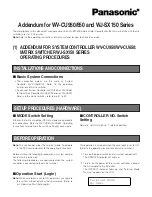
21
Borders
Puts borders (black bands) around the video image (top
and bottom (Ver.)/left and right (Hor.) edges). When the
output aspect ratio is set to
A
16:9
B
while the input aspect
ratio is 4:3, a black band will appear both left and right
edges. The width of this band can be changed.
Preset
There is a total of 2 fixed preset values and 4 preset
values that the user is able to store.
●
The fixed preset values are as follows:
4:3 F.Frame
[Frame AR(4:3), Active Input AR(1.33:1)]
16:9 F.Frame
[Frame AR(16:9), Active Input AR(1.78:1)]
Save
Saves the current set values for
A
Frame AR
B
,
A
Active
Input AR
B
,
A
Zoom
B
,
A
Pan
B
and
A
Borders
B
.
●
Note that upon saving, the previous preset values will be
overwritten.
.................................................................................................
INPUT ADJUST
Adjusts the input video images.
Border Level
When the aspect ratio is altered, a black band appears on
the top, bottom, left and right edges. Increasing the value
changes the color from black to gray. This setting applies
regardless of the input source or other settings.
Overscan
Enlarges the input video image equally in the horizontal/
vertical directions. Press this button to temporarily hide
the information around the video image.
●
This value corresponds to all input aspect ratios and is
independent from the
A
Zoom
B
value.
Line Offset
Enables adjustment of the video image in the vertical
direction when HDMI signals are input. This feature
allows different settings for NTSC and PAL/SECAM.
HDMI Input Control
Sets the signal format at the HDMI input terminal.
●
RGB 4:4:4 is a standard DVI format.
VCR Mode
The output timing is completely separated from the input
timing to ensure proper transmission of output signals
from this unit during playback on a video deck
(particularly during fast-forward, rewind, slow-motion and
pause).
●
On:
The output timing is separated from the input timing
regardless of the
A
Frame Rate
B
setting.
●
Off:
The output timing is dependent on the
A
Frame Rate
B
setting.
●
Auto:
Functions in the same way as
A
On
B
when signals from the
video deck are detected.
Film Mode
Detects film images when the film image signals undergo
progressive encoding. This to normally set to auto
detection (Auto).
●
Off:
Do not detect film during progressive encoding.
●
Film Bias:
Improves film mode detection, such as improving detection
of input film image when in the PAL/SECAM mode.
●
Auto:
Improves detection of film video signals.
Auto Priority
This feature changes the sequence of input selection
using an order of priority that is different from the
A
Auto
B
input selection setting.
Setting Values: Hor. (0
-
200), Ver. (0
-
200)
Default Value: Hor. (0), Ver. (0)
Setting Values:
4:3 F.Frame, 16:9 F.Frame, Preset 1
-
4
Default Value:
Setting Values: Preset 1
-
4
Setting Values: 0
-
100
Default Value: 0
Setting Values: 0
-
20
Default Value: 0
Setting Values: 0
-
30
Default Value: 0
Setting Values: RGB 4:4:4, YCbCr 4:2:2, YCbCr 4:4:4
Default Value: RGB 4:4:4
Setting Values: Off, On, Auto
Default Value: Off
Setting Values: Off, Film Bias, Auto
Default Value: Auto
Setting Values:
Video 1 (1
-
12), Video 2 (1
-
12), S-Video 1 (1
-
12),
S-Video 2 (1
-
12), Component 1 (1
-
12),
Component 2 (1
-
12), RGBHV (1
-
12),
HDMI 1 (1
-
12), HDMI 2 (1
-
12), HDMI 3, (1
-
2),
HDMI 4 (1
-
12), SDI (1
-
12)
Default Value:
Video 1 (1), Video 2 (2), S-Video 1 (3), S-Video 2 (4),
Component 1 (5), Component 2 (6), RGBHV (7),
HDMI 1 (8), HDMI 2 (9), HDMI 3 (10), HDMI 4 (11),
SDI (12)
ENGLISH
LD-HD1K.book Page 21 Tuesday, December 27, 2005 2:02 AM








































